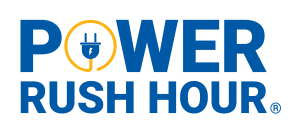Home » Power Rush Hour
Power Rush Hour

Power Rush Hour® takes place during the hottest summer months, from June through September. During this four-month period, your transmission costs for next year are calculated based on how much energy is being used at peak times. Also known as 4CP, it’s the measure of PEC’s total energy demand when our statewide transmission system experiences the most overall demand — the four “peaks” — each summer. Peaks tend to occur on the hottest days of the month (one each in June, July, August, and September), usually between the hours of 4 and 6 p.m.
By working together to use less energy during Power Rush Hour, you and your fellow members can help reduce your transmission costs the following year. Plus, reducing your energy use always saves you money on your next bill.
What are the Four Coincident Peaks (4CP)?
Each year, transmission costs are based on a value called Four Coincident Peaks, or 4CP. Our 4CP is the measure of PEC’s total energy demand when our statewide transmission system experiences the most overall demand — the four “peaks” — each summer. The lower PEC’s demand is during these peaks, the lower our transmission costs will be the following year.
The four peak events occur once each month in June, July, August, and September, usually between the hours of 4 and 6 p.m. They’re triggered when system demand is highest: usually on the hottest days of the month during the post-work/dinner hours when we’re all arriving home, turning on the air conditioning, starting dinner, and running large appliances, like dishwashers.
We can’t avoid peaks, but we can reduce the amount of energy we use during peak times. Every bit counts toward a lower bill next year.
What are transmission costs?
Transmission access charges are set by the Public Utility Commission of Texas (PUCT), a cost that is passed through directly to members without additional charges. Electric transmission costs have nearly doubled in the past seven years and impact every PEC member. But together we can reduce these costs.
The Transmission Cost of Service (TCOS) pass-through charge on your electric bill is used to recover the cost PEC pays to access the statewide transmission system. PEC passes on the cost to use transmission infrastructure as a direct passthrough, meaning there are no additional costs added. For details, please see section 500.1.8, page 46 of 82 of the Tariff and Business Rules.
Transmission access charges are set by the Public Utility Commission of Texas (PUCT) based on energy demand on the cooperative’s system during four 15-minute summer peak events, or 4 Coincident Peaks (4CP). PEC’s system demand is determined by averaging all members’ summer energy consumption during the 4CP in each of the four summer months — June, July, August, and September.
Each month, the PUCT updates the transmission access rate. As a result, the higher PEC’s energy demand is during the 4CP events, the more the cooperative will be charged in transmission charges the following year. The PUCT’s approved rate is multiplied by PEC’s 4CP to calculate our monthly transmission access charges, and that cost is passed directly through to members.
Conversely, by lowering our energy use during a 4CP event, we can enjoy a lower rate since we are effectively using fewer grid resources.
Take a look at your monthly bill. For most residential members, the transmission costs make up about 8-12% of the total due. If you and your fellow PEC members all take on Power Rush Hour together, you can reduce that cost on your bills.
ERCOT alerts
Learn the different ERCOT alerts and their meanings.
Interested in more ways to save?
Find energy-saving tips you can use anytime.